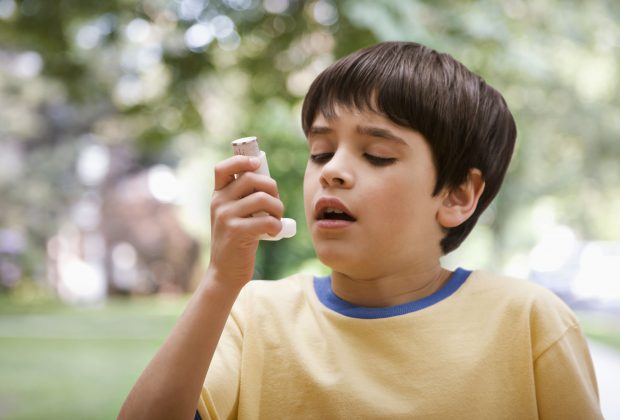What is asthma?
Asthma is a disease of your child’s lungs and the tubes that bring air to the lungs. With asthma, your child’s airways are constantly irritated and often become swollen and inflamed. Excess mucus forms in the airways. When your child’s airways are swollen and full of mucus, breathing becomes difficult. Children who have asthma often have these symptoms:
- Coughing
- Wheezing—a whistling sound as they breathe out
- Shortness of breath or trouble breathing
- Chest tightness
Asthma is a serious illness. A severe asthma episode that goes untreated can cause death. Asthma is a chronic disease. Asthma doesn’t ever go away, but it can be managed.
What medications are available to treat my child’s asthma?
For your child’s doctor, prescribing medications for asthma is very complicated. Each case of childhood asthma has a unique combination of symptoms and responses to treatment. Each child’s environment is unique. Each child’s needs can vary with the season and a number of other factors. For example, how many respiratory infections does the child have? How much exercise does he or she get? Your child’s doctor may need several weeks or months to find the right medications to keep your child’s asthma under control. You will need to be patient and work with the doctor during this process. You will also need to help your child understand that getting relief may take time.
Your child’s doctor will use two types of medicines to treat your child’s asthma—(1) a controller medication and (2) a rescue, or quick-relief, medication. Your child will take a controller medication each day to prevent or reduce airway inflammation. For asthma episodes or symptoms, your child will use a rescue medication. Rescue medications relax the muscles that tighten around the airways during an asthma episode, and they make breathing easier. Examples of these two types of medications are listed in the table.
What else can I do?
Medications represent only a part of your child’s asthma treatment. Three ways you can help your child manage his or his asthma are to:
- Learn as much as you can about childhood asthma and asthma medications. Use the resources listed at the end of this brochure as a place to start. Your doctor or health care provider and your pharmacist can suggest additional sources of information.
- Know what triggers your child’s asthma. Does your child have an asthma episode after running outside on a cold day? Does playing with Grandma’s cat start your child wheezing? Write down anything associated with an episode and play detective until you have tracked down all the triggers—then try to avoid them.
- Monitor your child’s symptoms every day. Keep an asthma diary to record all the details you can about each asthma episode. The diary will be an invaluable resource for your child’s doctor and will help the doctor manage your child’s asthma. In addition, if your child is over 4 years old, your doctor or health care provider might suggest using a peak flow meter to measure your child’s ability to breathe each day.
What are the treatment goals?
Even after your child has a routine to manage his or her asthma, it is still important to keep track of how he or she is doing. Here’s what well-managed asthma looks like:
- Asthma symptoms are under control.
- Physical activities are normal for your child’s age.
- Your child can sleep through the night.
- Your child doesn’t miss school because of asthma.
- Your child feels good about him- or herself and does not think of him- or herself as a sick person. After all, your child is so much more than the asthma. Encourage your child to be confident about confronting challenges and facing life.
Talk to your doctor if you notice a change in any of these aspects of your child’s life.
What Your Child’s Doctor Might Prescribe |
How Your Child Will Take the Medication |
|
Controller Medications |
|
| Cromolyn sodium/nedocromil sodium | By metered-dose inhaler or nebulizer. |
Inhaled corticosteroid, for example,
|
By metered-dose inhaler or dry-powder inhaler. A nebulizer is used for Pulmicort (budesonide) Respules™. |
Oral corticosteroid, for example,
|
By mouth as a tablet, liquid, or syrup. |
Leukotriene modifier, for example,
|
By mouth as a tablet. |
Long-acting bronchodilator, for example,
|
By mouth as a tablet or capsule or by metered-dose inhaler or dry-powder inhaler. |
|
Rescue or Quick-Relief Medications |
|
Short-acting beta2-agonist, for example,
|
By metered-dose inhaler, autohaler or breath-actived metered-dose inhaler, drypowder inhaler, or nebulizer. |
Oral corticosteroid, for example,
|
By mouth as a tablet or liquid. |
Anticholinergic, for example:
|
By metered-dose inhaler or nebulizer. |
Where can I get more information about children and asthma?
Asthma organizations and pharmaceutical companies are both good sources of information about childhood asthma and asthma medications. For example, try these resources:
- American Academy of Allergy, Asthma, and Immunology, 1-800-822-2762
- American Lung Association, 1-800-LUNG-USA (1-800-586-4872)
- Asthma and Allergy Foundation of America, 1-800-7-ASTHMA (1-800-727-8462)
- Asthma and Allergy Network/Mothers of Asthmatics, 1-800-878-4403
- AstraZeneca, 1-800-237-8898

